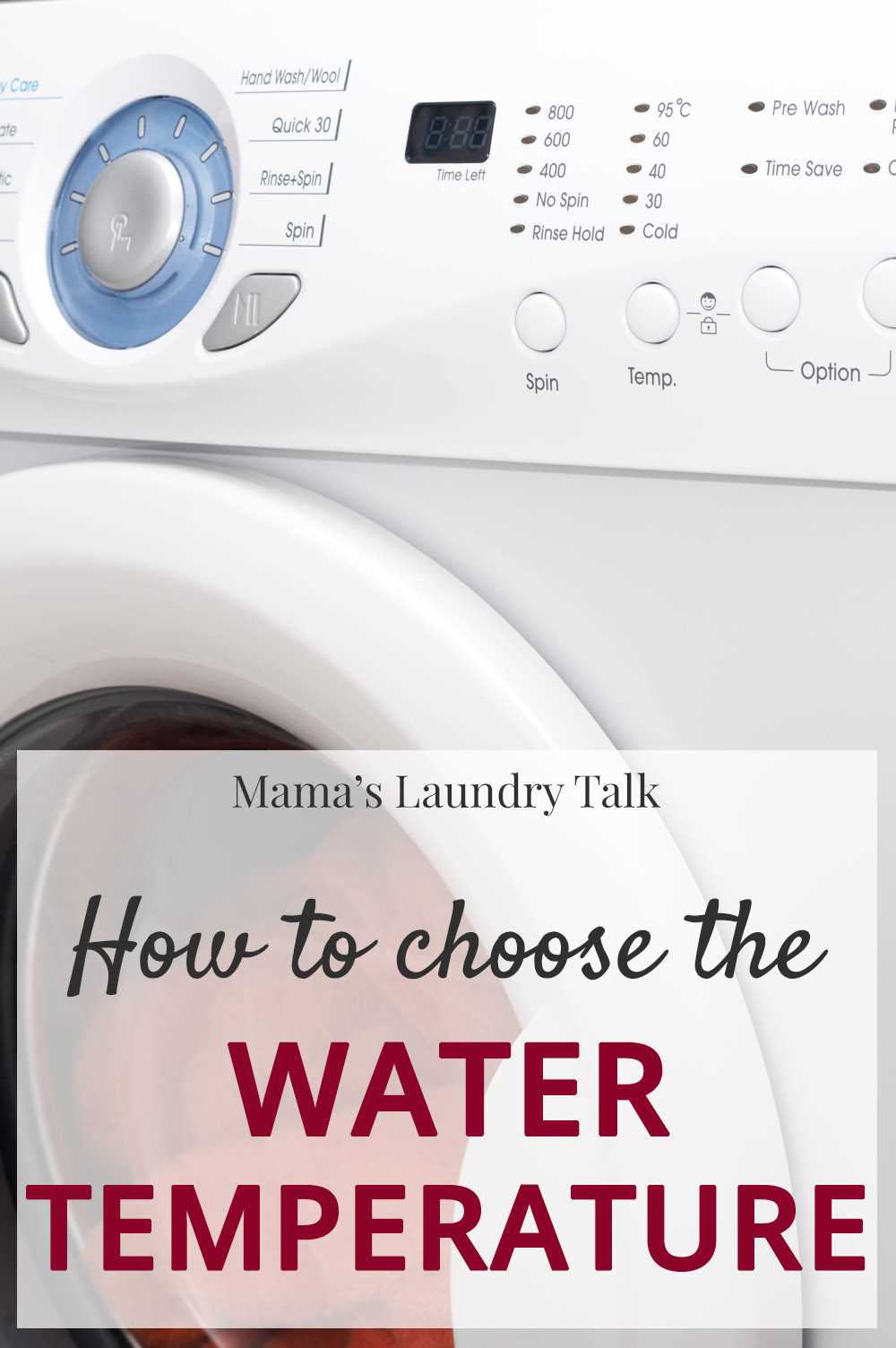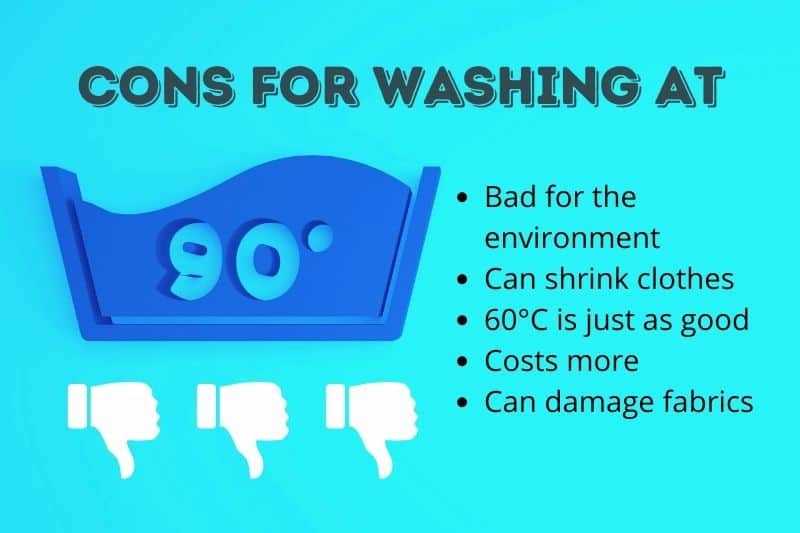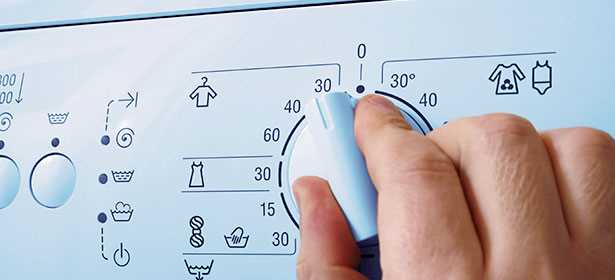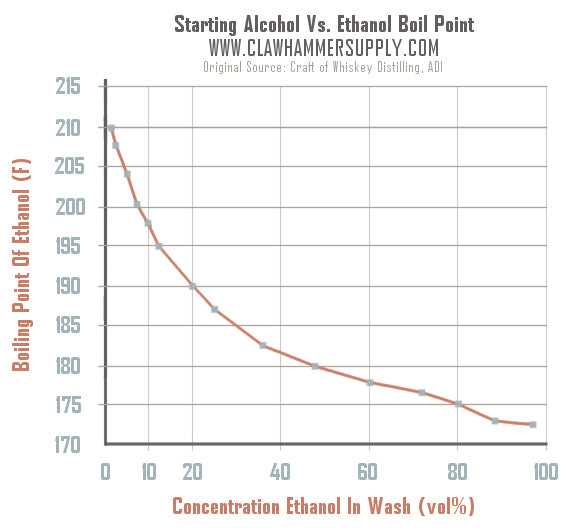




When it comes to doing laundry, most of us have a basic understanding of the different wash cycles and temperatures. However, one cycle that can be a bit confusing is the boil wash. What temperature is a boil wash? And when should you use it?
A boil wash is a cycle that uses extremely hot water to clean and disinfect your clothes. The exact temperature of a boil wash can vary depending on the specific washing machine, but it is typically between 90 and 100 degrees Celsius (194-212 degrees Fahrenheit).
The high temperature of a boil wash is designed to kill bacteria, dust mites, and other allergens that may be lurking in your clothes. It is especially useful for items that have come into contact with bodily fluids, such as bedding or baby clothes.
However, there are a few things to keep in mind when using a boil wash. First, not all fabrics can withstand such high temperatures, so you should check the care label on your clothes before using this cycle. Second, the intense heat of a boil wash can cause some fabrics to shrink or fade, so it’s important to use this cycle sparingly and only when necessary.
In conclusion, a boil wash is a powerful cleaning cycle that uses extremely hot water to kill bacteria and allergens. It can be a great option for disinfecting heavily soiled items, but it’s important to use it cautiously and only on fabrics that can withstand the high temperature.
The Importance of Boil Washing

Boil washing, also known as hot water wash, is a laundry technique that involves washing clothes at high temperatures. This process is considered important for several reasons:
- Kills Germs and Bacteria: Boil washing helps to effectively kill germs, bacteria, and other microbial organisms that may be present on clothes. High temperatures help eliminate these pathogens, making clothes fresh and hygienic.
- Removes Tough Stains: The hot water used in boil washing is extremely effective in breaking down and removing tough stains, such as oil or grease. The heat helps to dissolve the stains, allowing for effective stain removal.
- Sanitizes Clothing: Boil washing is particularly useful for sanitizing certain types of clothing, such as baby clothes, underwear, and towels. These items tend to come in contact with bodily fluids and can harbor bacteria. Boil washing ensures that these items are thoroughly sanitized.
- Prevents Spread of Infections: Boil washing is especially important when dealing with contagious illnesses or infections. Washing clothes at high temperatures helps prevent the spread of diseases, as the heat kills any pathogens present on the fabric.
- Reduces Allergens: Boil washing can help reduce allergens, such as pollen or dust mites, that may be present on clothes. High temperatures are effective in breaking down and eliminating these allergens, making clothes safer for individuals with allergies or sensitivities.
- Great for Whites and Light-Colored Clothes: Boil washing is particularly beneficial for white or light-colored clothes. The high temperatures help in maintaining their brightness and preventing yellowing or dinginess.
While boil washing can be beneficial in many cases, it is important to note that not all fabrics or garments can withstand high temperatures. Some delicate fabrics or clothing with special care instructions may be damaged by boil washing. It is always recommended to check the care labels and guidelines provided by the garment manufacturer before washinat high temperatures.
Understanding the Benefits and Uses

Boil washing is a laundry technique that involves washing clothes at high temperatures, typically between 90-100°C (194-212°F). This extreme heat helps to remove tough stains, kill bacteria, and eliminate odors that regular washing may not be able to tackle.
Benefits of Boil Washing
- Stain Removal: Boil washing is highly effective at removing stubborn stains, such as oil, grease, blood, and food.
- Bacteria Elimination: The high temperatures of a boil wash can kill most bacteria and germs, making it an excellent option for heavily soiled items or items that have come into contact with bodily fluids.
- Odor Elimination: Boil washing can help to remove strong odors from clothes, including cigarette smoke, pet smells, and sweat.
Uses of Boil Washing
While boil washing is not suitable for all fabrics and garments, it can be beneficial in certain situations, including:
- Bedding and Linens: Boil washing can be particularly effective for heavily soiled bedding and linens, ensuring they are thoroughly cleaned and free from bacteria.
- Baby Items: Boil washing is recommended for baby items, such as cloth diapers, as it helps to sanitize and eliminate any bacteria that may be present.
- Workwear and Uniforms: Workwear and uniforms that are exposed to dirt, grease, and other contaminants can benefit from boil washing to ensure they are hygienically clean.
It is important to note that boil washing may not be suitable for all fabrics, as it can cause damage or shrinkage. Always check the care label and follow the manufacturer’s instructions before attempting a boil wash. Additionally, ensure that your washing machine is capable of reaching the necessary high temperatures before attempting a boil wash cycle.
What Temperature Is a Boil Wash?

A boil wash is a laundry cycle that uses extremely hot water to clean and sanitize clothes. The high temperature helps to kill bacteria, viruses, and other microbes that may be present on the clothes. This type of wash cycle is typically used for items that require deep cleaning, such as heavily soiled clothes, baby clothes, and cloth diapers.
The temperature of a boil wash can vary depending on the washing machine and the settings chosen. In general, a boil wash is set at a temperature of 90°C (194°F) or higher. However, it’s important to check the specific temperature setting on your washing machine to ensure that it reaches the desired temperature.
When using a boil wash, it’s important to follow the manufacturer’s instructions and guidelines to prevent damage to your clothes and washing machine. Some fabrics may not be suitable for a boil wash, as the high temperature can cause shrinking, fading, or other damage. It’s a good idea to check the care label on your clothes before using a boil wash.
Benefits of a Boil Wash:
- Kills germs: The high temperature of a boil wash helps to eliminate bacteria, viruses, and other pathogens that may be present on your clothes.
- Removes tough stains: Boiling water can help to loosen and remove stubborn stains from your clothes, making them look cleaner and fresher.
- Sanitizes baby clothes and diapers: Boil washing is often recommended for baby clothes and diapers, as it helps to kill germs and keep them hygienic.
Precautions:

- Check fabric suitability: Not all fabrics can withstand the high temperature of a boil wash. Check the care label on your clothes before using this wash cycle.
- Protect delicate items: Delicate items, such as lingerie and silk, should not be washed in a boil wash as it can cause damage to the fabric.
- Follow manufacturer instructions: Always follow the washing machine manufacturer’s instructions for using a boil wash to prevent damage to your machine and clothes.
In conclusion, a boil wash is a laundry cycle that uses very hot water to clean and sanitize clothes. It is typically set at a temperature of 90°C (194°F) or higher and is used for heavily soiled items or those that require deep cleaning. However, it’s important to check the specific temperature setting on your washing machine and consider fabric suitability before using a boil wash.
Determining the Ideal Temperature for Different Fabrics
When it comes to washing clothes, selecting the right water temperature is crucial to ensure that your fabrics are thoroughly cleaned without getting damaged. Different fabrics require different water temperatures to achieve the best results. Here is a guide to help you determine the ideal temperature for washing various types of fabrics:
Hot Water (50-60°C)
- Cotton: Cotton fabrics can withstand high temperatures, making hot water ideal for removing tough stains and deep cleaning.
- White or colour-fast linens: Hot water helps to kill bacteria and removes stains effectively from these fabrics.
Warm Water (40-50°C)
- Polyester: Warm water is suitable for washing polyester, as it helps to remove dirt and stains without causing any damage to the fabric.
- Blended fabrics: Fabrics that are a combination of natural and synthetic fibers, such as cotton-polyester blends, can be safely washed in warm water.
- Synthetic fabrics: Materials like nylon, spandex, and acrylic can be washed effectively in warm water.
Cool Water (20-30°C)
- Delicate fabrics: Silk, wool, and cashmere should be washed in cool water to prevent shrinking, fading, or distortion.
- Darker colours: Cool water helps to preserve the vibrancy of dark-coloured fabrics and prevents colour bleeding or fading.
Remember to always check the care label on your clothes for specific temperature recommendations. This guide provides general guidelines, but there may be variations depending on the specific fabric and garment.
It’s worth noting that some washing machines may have temperature settings labeled differently, such as “hot,” “warm,” or “cool.” In these cases, make sure to adjust the temperature accordingly to match the fabric requirements.
By selecting the appropriate water temperature for your fabrics, you can ensure that your clothes are cleaned effectively while maintaining their quality and longevity.
How to Boil Wash Properly

Step 1: Prepare the Items
Before starting a boil wash, gather all the items you want to clean. Make sure to check the care instructions on each item to ensure they can withstand high temperatures. Remove any delicate or non-washable items from the batch.
Step 2: Sort the Items
Separate the items based on their colors and fabric types. It is important to wash similar items together to prevent color bleeding and fabric damage. Create different piles for whites, colors, and darks, as well as delicate fabrics.
Step 3: Fill the Washing Machine
Load the selected items into the washing machine, making sure not to overload it. Leave enough space for the items to freely move during the wash cycle. If needed, divide the load into multiple batches.
Step 4: Set the Temperature
Most washing machines have a specific setting for boil wash. Choose this setting or set the temperature manually to the highest available option, usually around 90°C (194°F). Consult the user manual of your washing machine if unsure.
Step 5: Add Detergent
Add the appropriate amount of detergent to the detergent dispenser or directly into the drum. Use a detergent suitable for high temperatures to ensure effective cleaning and sanitization. Refer to the detergent’s packaging for dosage instructions.
Step 6: Start the Wash Cycle
Close the washing machine door and select the desired wash cycle. Start the cycle and allow the machine to complete the wash and rinse cycles at the high temperature. This will help kill bacteria, remove tough stains, and freshen the items, restoring their cleanliness.
Step 7: Remove and Dry the Items
Once the wash cycle is complete, promptly remove the items from the washing machine. Hang or lay them out to dry, following the care instructions on each item. Some items may require air drying, while others can be tumble dried on a low heat setting.
Step 8: Clean the Washing Machine
After completing the boil wash, it is essential to clean your washing machine to remove any residue or bacteria. Run an empty cycle with hot water and a washing machine cleaner to maintain its performance and hygiene.
Step 9: Follow Safety Precautions
Boil washing involves high temperatures, so it is crucial to follow safety precautions. Avoid touching hot surfaces of the washing machine and take care when handling hot items. Also, keep children and pets away from the area during the wash cycle.
Step 10: Repeat as Needed
If necessary, repeat the boil wash process regularly or as recommended by the item’s care instructions. Boil washing can be an effective way to deep clean and sanitize certain items, especially those that require extra care and attention.
Step-by-Step Instructions for Successful Boil Washing
1. Preparing the Garments
Before starting the boil wash, separate the garments according to color and fabric type. This will help prevent any damage or color bleeding during the process.
If you’re unsure about the fabric or colorfastness, perform a patch test on a hidden area of the garment to check for any negative effects.
2. Filling the Washing Machine
Fill the washing machine drum with enough water to submerge the garments fully. Make sure there is enough room for the clothes to move freely during the wash cycle.
Note: The water temperature for a boil wash is typically around 208-212°F (98-100°C).
3. Adding Detergent
Add the appropriate amount of detergent suitable for boiling washes. Follow the manufacturer’s instructions on the detergent packaging for the correct dosage.
Tip: It’s recommended to use a heavy-duty detergent specifically designed for high-temperature washes.
4. Load the Garments
Add the pre-sorted garments to the washing machine. Ensure that the drum is not overloaded and that there is enough space for the clothes to move freely.
Caution: Avoid overloading the washing machine, as it can affect the cleaning efficiency and potentially damage the garments.
5. Start the Boil Wash Cycle
Close the washing machine door and select the boil wash cycle on the machine’s control panel. Start the cycle and let the machine do its job.
6. Monitor the Wash Cycle

While the boil wash is in progress, keep an eye on the machine to ensure that everything is running smoothly. If any issues arise, such as excessive noise or leaking, stop the cycle immediately and seek professional assistance if needed.
7. Post-Wash Care
After the boil wash cycle is complete, remove the garments from the machine promptly. Hang or lay them flat to dry, depending on the fabric type.
Check the garments for any remaining stains or odors. If necessary, repeat the boil wash or use appropriate stain removal methods.
8. Cleaning the Washing Machine
It’s important to clean the washing machine after a boil wash to remove any remaining detergent or residue. Follow the manufacturer’s instructions for cleaning and maintenance.
9. Store or Use the Clean Garments
Once the garments are dry, fold or hang them properly and store or use as desired. Enjoy the fresh and thoroughly cleaned clothes!
10. Safety Precautions
When handling hot water and garments during a boil wash, it’s important to take some safety precautions:
- Use protective gloves to prevent burns or skin irritation.
- Keep children and pets away from the washing machine during the cycle.
- Follow all safety instructions provided by the washing machine manufacturer.
With these step-by-step instructions, you’ll be able to successfully perform a boil wash and ensure that your garments are thoroughly cleaned and sanitized. Happy washing!
Boil Wash vs. Regular Washing
A boil wash is a laundry cycle that uses very high temperatures to thoroughly clean and sanitize clothing and fabrics. In contrast, regular washing refers to the standard laundry cycles that most washing machines offer.
Temperature
The key difference between a boil wash and regular washing is the temperature reached during the cycle. While regular washing machines typically have temperature options ranging from cold to hot, a boil wash specifically heats water to a boiling point, which is typically 100 degrees Celsius or 212 degrees Fahrenheit.
Effectiveness
Boil washing is more effective in removing tough stains, dirt, and bacteria from fabrics due to the high temperature. The heat helps break down and dissolve stains, while also killing most germs and bacteria present on the clothing. Regular washing can also be effective for general cleaning purposes, but it may not be as thorough as a boil wash.
Suitability

A boil wash is typically recommended for certain types of fabrics and items that require deep cleaning, such as heavily soiled clothes, baby items, kitchen towels, and underwear. It is also useful for disinfecting and sanitizing items during illness outbreaks or in households with immunocompromised individuals. Regular washing is suitable for everyday clothing and fabrics that are not heavily soiled or contaminated.
Care Instructions
It is important to follow the care instructions on clothing labels to determine if a boil wash is appropriate. Some fabrics may not withstand the high temperatures of a boil wash and may shrink or become damaged. In such cases, regular washing with appropriate temperature settings is recommended.
Time and Energy Consumption
A boil wash generally takes longer than a regular washing cycle due to the time required to heat the water to boiling point. Additionally, the high temperatures of a boil wash can consume more energy compared to regular washing. It is important to consider these factors when deciding whether to use a boil wash or regular washing.
| Boil Wash | Regular Washing | |
|---|---|---|
| Temperature | 100°C or 212°F | Variable (typically up to 60°C or 140°F) |
| Effectiveness | Thoroughly cleans and sanitizes | Effective for general cleaning |
| Suitability | Heavily soiled items, baby items, kitchen towels, underwear | Everyday clothing, lightly soiled items |
| Care Instructions | Check fabric labels for suitability | Follow care instructions on labels |
| Time and Energy Consumption | Longer cycle, higher energy consumption | Shorter cycle, lower energy consumption |
Overall, a boil wash is a powerful option for deep cleaning and sanitizing laundry, while regular washing is more suitable for everyday clothing maintenance. It is important to choose the appropriate wash cycle based on the specific needs of your laundry and follow the care instructions on fabric labels to avoid damage.
FAQ
What temperature is considered a boil wash?
A boil wash is typically done at a temperature of 100 degrees Celsius or 212 degrees Fahrenheit.
Why would someone need to do a boil wash?
A boil wash is useful for killing bacteria, germs, and allergens that may be present on clothing or linens. It is commonly used for items like baby clothes, towels, and bedding.
Can I do a boil wash with delicate fabrics?
No, it is not recommended to do a boil wash with delicate fabrics. The high temperature can damage and shrink delicate materials. Stick to using a lower temperature and a gentle cycle for delicate items.
How long does a boil wash cycle usually take?
A boil wash cycle can take anywhere from 60 to 90 minutes, depending on the specific washing machine and settings used. It is a longer cycle compared to regular wash cycles.











